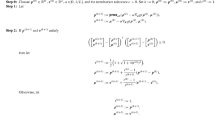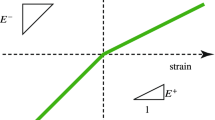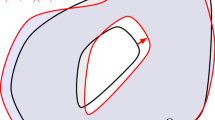Abstract
It is classical that, when the small deformation is assumed, the incremental analysis problem of an elastoplastic structure with a piecewise-linear yield condition and a linear strain hardening model can be formulated as a convex quadratic programming problem. Alternatively, this paper presents a different formulation, an unconstrained nonsmooth convex optimization problem, and proposes to solve it with an accelerated gradient-like method. Specifically, we adopt an accelerated proximal gradient method, that has been developed for a regularized least squares problem. Numerical experiments show that the presented algorithm is effective for large-scale elastoplastic analysis. Also, a simple warm-start strategy can speed up the algorithm when the path-dependent incremental analysis is carried out.














Similar content being viewed by others
Notes
Conversion to SOCP is not unique.
References
Acary V, Brogliato B (2008) Numerical methods for nonsmooth dynamical systems. Springer, Berlin
Anjos MF, Lasserre JB (eds) (2012) Handbook on semidefinite, conic and polynomial optimization. Springer, New York
Beck A, Teboulle M (2009) A fast iterative shrinkage-thresholding algorithm for linear inverse problems. SIAM J Imaging Sci 2:183–202
Benson HY, Shanno DF (2007) An exact primal-dual penalty method approach to warm-starting interior-point methods for linear programming. Comput Optim Appl 38:371–399
Ben-Tal A, Nemirovski A (2001) Lectures on modern convex optimization: analysis, algorithms, and engineering applications. SIAM, Philadelphia
Bergamaschi L, Gondzio J, Venturin M, Zilli G (2011) Inexact constraint preconditioners for linear systems arising in interior point methods. Comput Optim Appl 36:137–147. Erratum: Comput Optim Appl 49:401–406
Bisbos CD, Makrodimopoulos A, Pardalos PM (2005) Second-order cone programming approaches to static shakedown analysis in steel plasticity. Optim Methods Softw 20:25–52
Calafiore G, El Ghaoui L (2014) Optimization models. Cambridge University Press, Cambridge
Capurso M, Maier G (1970) Incremental elastoplastic analysis and quadratic optimization. Meccanica 5:107–116
Carbonetto P (2014) MATLAB interface for IPOPT. http://www.cs.ubc.ca/~pcarbo/ipopt-for-matlab/
Čermák M, Kozubek T, Sysala S, Valdman J (2014) A TFETI domain decomposition solver for elastoplastic problems. Appl Math Comput 231:634–653
Chambolle A, DeVore RA, Lee N-Y, Lucier BJ (1998) Nonlinear wavelet image processing: variational problems, compression, and noise removal through wavelet shrinkage. IEEE Trans Image Process 7:319–335
Combettes PL, Wajs VR (2005) Signal recovery by proximal forward-backward splitting. Multiscale Model Simul 4:1168–1200
Daubechies I, Defrise M, De Mol C (2004) An iterative thresholding algorithm for linear inverse problems with a sparsity constraint. Commun Pure Appl Math 57:1413–1457
De Donato O, Maier G (1976) Historical deformation analysis of elastoplastic structures as a parametric linear complementarity problem. Meccanica 11:166–171
de Souza Neto EA, Perić D, Owen DRJ (2008) Computational methods for plasticity: theory and applications. Wiley, Chichester
Dirkse SP, Ferris MC (1995) The PATH solver: a nommonotone stabilization scheme for mixed complementarity problems. Optim Methods Softw 5:123–156
Ferris MC, Munson TS (1999) Interfaces to PATH 3.0: design, implementation and usage. Comput Optim Appl 12:207–227
Ferris MC, Munson TS (2000) Complementarity problems in GAMS and the PATH solver. J Econ Dyn Control 24:165–188
Figueiredo MAT, Nowak RD (2003) An EM algorithm for wavelet-based image restoration. IEEE Trans Image Process 12:906–916
Goldstein T, O’Donoghue B, Setzer S, Baraniuk R (2014) Fast alternating direction optimization methods. SIAM J Imaging Sci 7:1588–1623
Grierson DE, Franchi A, DeDonato O, Corradi L (1979) Mathematical programming and nonlinear finite element analysis. Comput Methods Appl Mech Eng 17–18:497–518
Han W, Reddy BD (2013) Plasticity, 2nd edn. Springer, New York
Horn RA, Johnson CR (2013) Matrix analysis, 2nd edn. Cambridge University Press, Cambridge
John E, Yıldırım EA (2008) Implementation of warm-start strategies in interior-point methods for linear programming in fixed dimension. Comput Optim Appl 41:151–183
Johnson CA, Seidel J, Sofer A (2000) Interior-point methodology for 3-D PET reconstruction. IEEE Trans Med Imaging 19:271–285
Kaneko I (1979) Piecewise linear elastic-plastic analysis. Int J Numer Meth Eng 14:757–767
Kaneko I (1980) Complete solutions for a class of elastic-plastic structures. Comput Methods Appl Mech Eng 21:193–209
Kanno Y (2011) Nonsmooth mechanics and convex optimization. CRC Press, Boca Raton
Kanno Y, Martins JAC, Pinto da Costa A (2006) Three-dimensional quasi-static frictional contact by using second-order cone linear complementarity problem. Int J Numer Meth Eng 65:62–83
Kanno Y, Ohsaki M, Ito J (2002) Large-deformation and friction analysis of nonlinear elastic cable networks by second-order cone programming. Int J Numer Methods Eng 55:1079–1114
Kim S-J, Koh K, Lustig M, Boyd S, Gorinevsky D (2007) An interior-point method for large-scale \(\ell _{1}\)-regularized least squares. IEEE J Select Topics Signal Process 1:606–617
Krabbenhøft K, Lyamin AV (2012) Computational Cam clay plasticity using second-order cone programming. Comput Methods Appl Mech Eng 209–212:239–249
Krabbenhøft K, Lyamin AV, Sloan SW (2007a) Formulation and solution of some plasticity problems as conic programs. Int J Solids Struct 44:1533–1549
Krabbenhøft K, Lyamin AV, Sloan SW, Wriggers P (2007b) An interior-point algorithm for elastoplasticity. Int J Numer Methods Eng 69:592–626
Krichene W, Bayen AM, Bartlett PL (2015) Accelerated mirror descent in continuous and discrete time. In: Cortes C, Lawrence ND, Lee DD, Sugiyama M, Garnett R (eds) Advances in neural information processing systems 28 (NIPS 2015). Curran Associates, Red Hook, pp 2845–2853
Li H, Lin Z (2015) Accelerated proximal gradient methods for nonconvex programming. In: Cortes C, Lawrence ND, Lee DD, Sugiyama M, Garnett R (eds) Advances in neural information processing systems 28 (NIPS 2015). Curran Associates, Red Hook, pp 379–387
Maier G (1968) A quadratic programming approach for certain classes of non-linear structural problems. Meccanica 3:121–130
Maier G (1970) A matrix structural theory of piecewise linear elastoplasticity with interacting yield planes. Meccanica 5:54–66
Maier G (1984) Mathematical programming applications to structural mechanics: some introductory thoughts. Eng Struct 6:2–6
Maier G, Munro J (1982) Mathematical programming applications to engineering plastic analysis. Appl Mech Rev (ASME) 35:1631–1643
Makrodimopoulos A (2006) Computational formulation of shakedown analysis as a conic quadratic optimization problem. Mech Res Commun 33:72–83
Mitchell JE (2001) Restarting after branching in the SDP approach to MAX-CUT and similar combinatorial optimization problem. J Combin Optim 5:151–166
Nesterov Y (2004) Introductory lectures on convex optimization: a basic course. Kluwer Academic Publishers, Dordrecht
Nineb S, Alart P, Dureisseix D (2007) Domain decomposition approach for non-smooth discrete problems, example of a tensegrity structure. Comput Struct 85:499–511
O’Donoghue B, Candès E (2015) Adaptive restart for accelerated gradient schemes. Found Comput Math 15:715–732
Parikh N, Boyd S (2014) Proximal algorithms. Found Trends Optim 1:127–239
Portugal LF, Resende MGC, Veiga G, Júdice JJ (2000) A truncated primal-infeasible dual-feasible network interior point method. Networks 35:91–108
Simo JC, Hughes TJR (1998) Computational inelasticity. Springer, New York
Smith DL (1978) The Wolfe–Markowitz algorithm for nonholonomic elastoplastic analysis. Eng Struct 1:8–16
Spiliopoulos KV, Patsios TN (2010) An efficient mathematical programming method for the elastoplastic analysis of frames. Eng Struct 32:1199–1214
Su W, Boyd S, Candès EJ (2014) A differential equation for modeling Nesterov’s accelerated gradient method: theory and insights. In: Ghahramani Z, Welling M, Cortes C, Lawrence ND, Weinberger KQ (eds) Advances in neural information processing systems 27 (NIPS 2014). Curran Associates, Red Hook, pp 2510–2518
Tangaramvong S, Tin-Loi F (2007) A complementarity approach for elastoplastic analysis of strain softening frames under combined bending and axial force. Eng Struct 29:742–753
Tangaramvong S, Tin-Loi F (2008) Simultaneous ultimate load and deformation analysis of strain softening frames under combined stresses. Eng Struct 30:664–674
Tangaramvong S, Tin-Loi F, Song C (2012) A direct complementarity approach for the elastoplastic analysis of plane stress and plane strain structures. Int J Numer Methods Eng 90:838–866
The MathWorks, Inc.: MATLAB Documentation. http://www.mathworks.com/. Accessed Dec 2014
Tin-Loi F, Xia SH (2001) Nonholonomic elastoplastic analysis involving unilateral frictionless contact as a mixed complementarity problem. Comput Methods Appl Mech Eng 190:4551–4568
Tibshirani R (1996) Regression shrinkage and selection via the lasso. J R Stat Soc Ser B (Methodol) 58:267–288
Tibshirani R (2011) Regression shrinkage and selection via the lasso: a retrospective. J R Stat Soc Ser B (Methodol) 73:273–282
Wächter A, Biegler LT (2006) On the implementation of an interior-point filter line-search algorithm for large-scale nonlinear programming. Math Program 106:25–57
Wakefield RR, Tin-Loi F (1990) Large scale nonholonomic elastoplastic analysis using a linear complementarity formulation. Comput Methods Appl Mech Eng 84:229–242
Wriggers P (2006) Computational contact mechanics, 2nd edn. Springer, Berlin
Yonekura K, Kanno Y (2012) Second-order cone programming with warm start for elastoplastic analysis with von Mises yield criterion. Optim Eng 13:181–218
Acknowledgments
The author is grateful to Wataru Shimizu for fruitful discussions. This work is partially supported by JSPS KAKENHI (C) 26420545 and (C) 15KT0109.
Author information
Authors and Affiliations
Corresponding author
Appendices
Appendix 1: SOCP formulation of problem (12)
In this section, we explain how problem (12) is recast as a second-order cone programming (SOCP) problem.
The second-order cone in \({\mathbb {R}}^{n}\) is defined by
SOCP is a minimization (or maximization) of a linear objective function under some second-order cone constraints and affine constraints.
The inequality constraints in (12c) can be written as second-order cone constraints as
The constraints in (12b) are affine (i.e., linear equality) constraints. To convert the objective function to a linear one, we introduce auxiliary variables, \(\xi \in {\mathbb {R}}\) and \(\zeta \in {\mathbb {R}}\), that serve as upper bounds for the quadratic terms in (12a). Namely, we consider the following constraints:
The convex quadratic inequality constraint in (61) can be rewritten equivalently as (Ben-Tal and Nemirovski 2001)
This is a second-order cone constraint. Constraint (62) can be rewritten in the same manner.
The upshot is that problem (12) can be converted to the following SOCP problem:Footnote 1
Here, \(\Delta c_{{\rm e1}},\dots ,\Delta c_{{\rm e}m}\), \(\xi \), \(\Delta \gamma _{1},\dots ,\Delta \gamma _{m}\), \(\zeta \), and \(\Delta {\varvec{u}}\) are variables to be optimized.
Appendix 2: Equivalence of (21) and (23)
As one of fundamental properties of the proximal mapping, we can show, for any \(\alpha > 0\), that \({\varvec{p}} \in {\mathbb {R}}^{m}\) satisfies
if and only if it satisfies
See, e.g., Parikh and Boyd (2014). For the reader’s convenience, essentials of the proof are repeated here.
Suppose that \({\varvec{p}}\) satisfies (63). This is equivalent to
Let \({\varvec{s}} := {\varvec{p}} - \alpha \nabla _{{\varvec{p}}}g_{1}({\varvec{v}},{\varvec{p}})\) for notational simplicity. Then (65) is rewritten as
which is equivalent to
By definition, (66) is equivalent to (64).
Appendix 3: Algorithm for piecewise-linear hardening
We begin with computation of the gradient of \(g_{1}\) defined by (58). In a manner similar to Sect. 3.3, it is convenient to define \({\varvec{e}} \in {\mathbb {R}}^{m}\) by
which corresponds to the vector of incremental elastic elongation, \(\Delta \varvec{c}_{{\rm e}}\), in problem (55). Then the gradient of \(g_{1}\) can be calculated as
where
Moreover, the Hessian matrix of \(g_{1}\) is written as

Since \(k_{i}>0\), \(h_{i1}>0\), \(\eta _{i}>0\) \((i=1,\dots ,m)\) and B is of row full rank for a kinematically determinate truss, \(\nabla ^{2} g_{1}({\varvec{v}},{\varvec{p}},{\varvec{s}})\) is positive definite. In a manner similar to Sect. 3.3, the proximal mapping of \(\alpha g_{2}\) with \(\alpha > 0\) can be computed as
We are now in position to describe an accelerated proximal gradient method for solving problem (57).

At step 1 of Algorithm 3, auxiliary variables \(\varvec{\varepsilon }_{l}\), \({\varvec{w}}_{l}\), and \({\varvec{s}}_{l}\) are used for convenience of computation.
Rights and permissions
About this article
Cite this article
Kanno, Y. A fast first-order optimization approach to elastoplastic analysis of skeletal structures. Optim Eng 17, 861–896 (2016). https://doi.org/10.1007/s11081-016-9326-1
Received:
Revised:
Accepted:
Published:
Issue Date:
DOI: https://doi.org/10.1007/s11081-016-9326-1




